C41 - Lewis Book Med Surg PDF

| Title | C41 - Lewis Book Med Surg |
|---|---|
| Author | Daisy Soloman |
| Course | Public Health Nursing |
| Institution | University of Utah |
| Pages | 15 |
| File Size | 207.8 KB |
| File Type | |
| Total Downloads | 116 |
| Total Views | 151 |
Summary
Lewis Book Med Surg...
Description
Chapter 41: Upper Gastrointestinal Problems Lewis: Medical-Surgical Nursing, 10th Edition MULTIPLE CHOICE 1. A 53-yr-old male patient with deep partial-thickness burns from a chemical spill in the
workplace experiences severe pain followed by nausea during dressing changes. Which action will be most useful in decreasing the patient’s nausea? a. Keep the patient NPO for 2 hours before dressing changes. b. Give the ordered prochlorperazine before dressing changes. c. Administer the prescribed morphine sulfate before dressing changes. d. Avoid performing dressing changes close to the patient’s mealtimes. ANS: C
Because the patient’s nausea is associated with severe pain, it is likely that it is precipitated by stress and pain. The best treatment will be to provide adequate pain medication before dressing changes. The nurse should avoid doing painful procedures close to mealtimes, but nausea or vomiting that occur at other times also should be addressed. Keeping the patient NPO does not address the reason for the nausea and vomiting and will have an adverse effect on the patient’s nutrition. Administration of antiemetics is not the best choice for a patient with nausea caused by pain. However, an antiemetic may be added later if the nausea persists despite pain management. DIF: Cognitive Level: Analyze (analysis) REF: 894 TOP: Nursing Process: Implementation MSC: NCLEX: Physiological Integrity 2. Which item should the nurse offer to the patient who is to restart oral intake after being NPO
due to nausea and vomiting? a. Glass of orange juice b. Dish of lemon gelatin
c. Cup of coffee with cream d. Bowl of hot chicken broth
ANS: B
Clear cool liquids are usually the first foods started after a patient has been nauseated. Acidic foods such as orange juice, very hot foods, and coffee are poorly tolerated when patients have been nauseated. DIF: Cognitive Level: Apply (application) REF: 894 TOP: Nursing Process: Implementation MSC: NCLEX: Physiological Integrity 3. A 38-year old woman receiving chemotherapy for breast cancer develops a Candida albicans
oral infection. The nurse will anticipate the need for hydrogen peroxide rinses. the use of antiviral agents. administration of nystatin tablets. referral to a dentist for professional tooth cleaning.
a. b. c. d.
ANS: C
Candida albicans infections are treated with an antifungal such as nystatin. Peroxide rinses would be painful. Oral saltwater rinses may be used but will not cure the infection. Antiviral agents are used for viral infections such as herpes simplex. Referral to a dentist is indicated for gingivitis but not for Candida infection. DIF: Cognitive Level: Apply (application) REF: 897 TOP: Nursing Process: Planning MSC: NCLEX: Physiological Integrity 4. Which finding in the mouth of a patient who uses smokeless tobacco is suggestive of oral
cancer? a. Bleeding during tooth brushing b. Painful blisters at the lip border c. Red, velvety patches on the buccal mucosa d. White, curdlike plaques on the posterior tongue ANS: C
A red, velvety patch suggests erythroplasia, which has a high incidence (>50%) of progression to squamous cell carcinoma. The other lesions are suggestive of acute processes (e.g., gingivitis, oral candidiasis, herpes simplex). DIF: Cognitive Level: Understand (comprehension) REF: 898 TOP: Nursing Process: Assessment MSC: NCLEX: Physiological Integrity 5. Which information will the nurse include when teaching adults to decrease the risk for cancers
of the tongue and buccal mucosa? a. Avoid use of cigarettes and smokeless tobacco. b. Use sunscreen when outside even on cloudy days. c. Complete antibiotic courses used to treat throat infections. d. Use antivirals to treat herpes simplex virus (HSV) infections. ANS: A
Tobacco use greatly increases the risk for oral cancer. Acute throat infections do not increase the risk for oral cancer, although chronic irritation of the oral mucosa does increase risk. Sun exposure does not increase the risk for cancers of the buccal mucosa. Human papillomavirus (HPV) infection is associated with an increased risk, but HSV infection is not a risk factor for oral cancer. DIF: Cognitive Level: Apply (application) REF: 898 TOP: Nursing Process: Planning MSC: NCLEX: Health Promotion and Maintenance 6. A patient who has gastroesophageal reflux disease (GERD) is experiencing increasing
discomfort. Which patient statement to the nurse indicates that additional teaching about GERD is needed? a. “I take antacids between meals and at bedtime each night.” b. “I sleep with the head of the bed elevated on 4 -inch blocks.” c. “I eat small meals during the day and have a bedtime snack.” d. “I quit smoking several years ago, but I still chew a lot of gum.” ANS: C
GERD is exacerbated by eating late at night, and the nurse should plan to teach the patient to avoid eating at bedtime. The other patient actions are appropriate to control symptoms of GERD.
DIF: Cognitive Level: Apply (application) REF: 902 TOP: Nursing Process: Evaluation MSC: NCLEX: Physiological Integrity 7. A 68-yr-old male patient with a stroke is unconscious and unresponsive to stimuli. After
learning that the patient has a history of gastroesophageal reflux disease (GERD), the nurse will plan to do frequent assessments of the patient’s a. apical pulse. c. breath sounds. b. bowel sounds. d. abdominal girth. ANS: C
Because GERD may cause aspiration, the unconscious patient is at risk for developing aspiration pneumonia. Bowel sounds, abdominal girth, and apical pulse will not be affected by the patient’s stroke or GERD and do not require more frequent monitoring than the routine. DIF: Cognitive Level: Apply (application) REF: 905 TOP: Nursing Process: Assessment MSC: NCLEX: Physiological Integrity 8. The nurse explaining esomeprazole (Nexium) to a patient with recurring heartburn describes
that the medication a. reduces gastroesophageal reflux by increasing the rate of gastric emptying. b. neutralizes stomach acid and provides relief of symptoms in a few minutes. c. coats and protects the lining of the stomach and esophagus from gastric acid. d. treats gastroesophageal reflux disease by decreasing stomach acid production. ANS: D
The proton pump inhibitors decrease the rate of gastric acid secretion. Promotility drugs such as metoclopramide (Reglan) increase the rate of gastric emptying. Cryoprotective medications such as sucralfate (Carafate) protect the stomach. Antacids neutralize stomach acid and work rapidly. DIF: Cognitive Level: Understand (comprehension) REF: 903 TOP: Nursing Process: Implementation MSC: NCLEX: Physiological Integrity 9. Which patient choice for a snack 3 hours before bedtime indicates that the nurse’s teaching
about gastroesophageal reflux disease (GERD) has been effective? c. Cherry gelatin with fruit d. Peanut butter and jelly sandwich
a. Chocolate pudding b. Glass of low-fat milk ANS: C
Gelatin and fruit are low fat and will not decrease lower esophageal sphincter (LES) pressure. Foods such as chocolate are avoided because they lower LES pressure. Milk products increase gastric acid secretion. High-fat foods such as peanut butter decrease both gastric emptying and LES pressure. DIF: Cognitive Level: Apply (application) REF: 902 TOP: Nursing Process: Evaluation MSC: NCLEX: Physiological Integrity 10. The nurse will anticipate teaching a patient experiencing frequent heartburn about a. a barium swallow. c. endoscopy procedures. b. radionuclide tests. d. proton pump inhibitors.
ANS: D
Because diagnostic testing for heartburn that is probably caused by gastroesophageal reflux disease (GERD) is expensive and uncomfortable, proton pump inhibitors are frequently used for a short period as the first step in the diagnosis of GERD. The other tests may be used but are not usually the first step in diagnosis. DIF: Cognitive Level: Apply (application) REF: 902 TOP: Nursing Process: Planning MSC: NCLEX: Physiological Integrity 11. A 58-yr-old woman who was recently diagnosed with esophageal cancer tells the nurse, “I do
not feel ready to die yet.” Which response by the nurse is most appropriate? a. “You may have quite a few years still left to live.” b. “Thinking about dying will only make you feel worse.” c. “Having this new diagnosis must be very hard for you.” d. “It is important that you be realistic about your prognosis.” ANS: C
This response is open ended and will encourage the patient to further discuss feelings of anxiety or sadness about the diagnosis. Patients with esophageal cancer have a low survival rate, so the response “You may have quite a few years still left to live” is misleading. The response beginning, “Thinking about dying” indicates that the nurse is not open to discussing the patient’s fears of dying. The response beginning, “It is important that you be realistic” discourages the patient from feeling hopeful, which is important to patients with any life-threatening diagnosis. DIF: Cognitive Level: Analyze (analysis) REF: 907 TOP: Nursing Process: Implementation MSC: NCLEX: Psychosocial Integrity 12. Which information will the nurse include for a patient with newly diagnosed gastroesophageal
reflux disease (GERD)? “Peppermint tea may reduce your symptoms.” “Keep the head of your bed elevated on blocks.” “You should avoid eating between meals to reduce acid secretion.” “Vigorous physical activities may increase the incidence of reflux.”
a. b. c. d.
ANS: B
Elevating the head of the bed will reduce the incidence of reflux while the patient is sleeping. Peppermint will decrease lower esophageal sphincter (LES) pressure and increase the chance for reflux. Small, frequent meals are recommended to avoid abdominal distention. There is no need to make changes in physical activities because of GERD. DIF: Cognitive Level: Apply (application) REF: 902 TOP: Nursing Process: Implementation MSC: NCLEX: Physiological Integrity 13. Which nursing action should be included in the postoperative plan of care for a patient after a
laparoscopic esophagectomy? a. Reposition the NG tube if drainage stops. b. Elevate the head of the bed to at least 30 degrees. c. Start oral fluids when the patient has active bowel sounds. d. Notify the doctor for any bloody nasogastric (NG) drainage. ANS: B
Elevation of the head of the bed decreases the risk for reflux and aspiration of gastric secretions. The NG tube should not be repositioned without consulting with the health care provider. Bloody NG drainage is expected for the first 8 to 12 hours. A swallowing study is needed before oral fluids are started. DIF: Cognitive Level: Apply (application) REF: 907 TOP: Nursing Process: Planning MSC: NCLEX: Physiological Integrity 14. When a patient is diagnosed with achalasia, the nurse will teach the patient that a. lying down after meals is recommended. b. a liquid or blenderized diet will be necessary. c. drinking fluids with meals should be avoided. d. treatment may include endoscopic procedures. ANS: D
Endoscopic and laparoscopic procedures are the most effective therapy for improving symptoms caused by achalasia. Keeping the head elevated after eating will improve esophageal emptying. A semisoft diet is recommended to improve esophageal emptying. Patients are advised to drink fluid with meals. DIF: Cognitive Level: Apply (application) REF: 908 TOP: Nursing Process: Planning MSC: NCLEX: Physiological Integrity 15. A patient vomiting blood-streaked fluid is admitted to the hospital with acute gastritis. To
determine possible risk factors for gastritis, the nurse will ask the patient about a. the amount of saturated fat in the diet. b. a family history of gastric or colon cancer. c. a history of a large recent weight gain or loss. d. use of nonsteroidal antiinflammatory drugs (NSAIDs). ANS: D
Use of an NSAID is associated with damage to the gastric mucosa, which can result in acute gastritis. Family history, recent weight gain or loss, and fatty foods are not risk factors for acute gastritis. DIF: Cognitive Level: Understand (comprehension) REF: 909 TOP: Nursing Process: Assessment MSC: NCLEX: Physiological Integrity 16. The nurse determines that teaching regarding cobalamin injections has been effective when
the patient with chronic atrophic gastritis states a. “The cobalamin injections will prevent gastric inflammation.” b. “The cobalamin injections will prevent me from becoming anemic.” c. “These injections will increase the hydrochloric acid in my stomach.” d. “These injections will decrease my risk for developing stomach cancer.” ANS: B
Cobalamin supplementation prevents the development of pernicious anemia. Chronic gastritis may cause achlorhydria, but cobalamin does not correct this. The loss of intrinsic factor secretion with chronic gastritis is permanent, and the patient will need lifelong supplementation with cobalamin. The incidence of stomach cancer is higher in patients with chronic gastritis, but cobalamin does not reduce the risk for stomach cancer.
DIF: Cognitive Level: Apply (application) REF: 910 TOP: Nursing Process: Evaluation MSC: NCLEX: Physiological Integrity 17. A patient has peptic ulcer disease that has been associated with Helicobacter pylori. About
which medications will the nurse plan to teach the patient? a. Sucralfate (Carafate), nystatin, and bismuth (Pepto-Bismol) b. Metoclopramide (Reglan), bethanechol (Urecholine), and promethazine c. Amoxicillin (Amoxil), clarithromycin (Biaxin), and omeprazole (Prilosec) d. Famotidine (Pepcid), magnesium hydroxide (Mylanta), and pantoprazole (Protonix) ANS: C
The drugs used in triple drug therapy include a proton pump inhibitor such as omeprazole and the antibiotics amoxicillin and clarithromycin. The other combinations listed are not included in the protocol for H. pylori infection. DIF: Cognitive Level: Apply (application) REF: 903 TOP: Nursing Process: Planning MSC: NCLEX: Physiological Integrity 18. Which action should the nurse in the emergency department anticipate for a young adult
patient who has had several episodes of bloody diarrhea? Obtain a stool specimen for culture. Administer antidiarrheal medication. Provide teaching about antibiotic therapy. Teach the adverse effects of acetaminophen (Tylenol).
a. b. c. d.
ANS: A
Patients with bloody diarrhea should have a stool culture for Escherichia coli O157:H7. Antidiarrheal medications are usually avoided for possible infectious diarrhea to avoid prolonging the infection. Antibiotic therapy in the treatment of infectious diarrhea is controversial because it may precipitate kidney complications. Acetaminophen does not cause bloody diarrhea. DIF: Cognitive Level: Apply (application) REF: 925 TOP: Nursing Process: Planning MSC: NCLEX: Physiological Integrity 19. The nurse will anticipate preparing an older patient who is vomiting “coffee-ground” emesis
for a. endoscopy. b. angiography.
c. barium studies. d. gastric analysis.
ANS: A
Endoscopy is the primary tool for visualization and diagnosis of upper gastrointestinal (GI) bleeding. Angiography is used only when endoscopy cannot be done because it is more invasive and has more possible complications. Barium studies are helpful in determining the presence of gastric lesions, but not whether the lesions are actively bleeding. Gastric analysis testing may help with determining the cause of gastric irritation, but it is not used for acute GI bleeding. DIF: Cognitive Level: Apply (application) REF: 922 TOP: Nursing Process: Planning MSC: NCLEX: Physiological Integrity
20. An adult with Escherichia coli O157:H7 food poisoning is admitted to the hospital with
bloody diarrhea and dehydration. Which prescribed action will the nurse question? a. Infuse lactated Ringer’s solution at 250 mL/hr. b. Monitor blood urea nitrogen and creatinine daily. c. Administer loperamide (Imodium) after each stool. d. Provide a clear liquid diet and progress diet as tolerated. ANS: C
Use of antidiarrheal agents is avoided with this type of food poisoning. The other orders are appropriate. DIF: Cognitive Level: Apply (application) REF: 926 TOP: Nursing Process: Implementation MSC: NCLEX: Physiological Integrity 21. Which information will the nurse include when teaching a patient with peptic ulcer disease
about the effect of ranitidine (Zantac)? “Ranitidine absorbs the excess gastric acid.” “Ranitidine decreases gastric acid secretion.” “Ranitidine constricts the blood vessels near the ulcer.” “Ranitidine covers the ulcer with a protective material.”
a. b. c. d.
ANS: B
Ranitidine is a histamine-2 (H2) receptor blocker that decreases the secretion of gastric acid. The response beginning, “Ranitidine constricts the blood vessels” describes the effect of vasopressin. The response “Ranitidine absorbs the gastric acid” describes the effect of antacids. The response beginning “Ranitidine covers the ulcer” describes the action of sucralfate (Carafate). DIF: Cognitive Level: Understand (comprehension) REF: 903 TOP: Nursing Process: Implementation MSC: NCLEX: Physiological Integrity 22. A young adult patient is hospitalized with massive abdominal trauma from a motor vehicle
crash. The patient asks the nurse about the purpose of receiving famotidine (Pepcid). The nurse will explain that the medication w ill a. decrease nausea and vomiting. b. inhibit development of stress ulcers. c. lower the risk for H. pylori infection. d. prevent aspiration of gastric contents. ANS: B
Famotidine is administered to prevent the development of physiologic stress ulcers, which are associated with a major physiologic insult such as massive trauma. Famotidine does not decrease nausea or vomiting, prevent aspiration, or prevent Helicobacter pylori infection. DIF: Cognitive Level: Apply (application) REF: 903 TOP: Nursing Process: Implementation MSC: NCLEX: Physiological Integrity 23. An older patient with a bleeding duodenal ulcer has a nasogastric (NG) tube in place. The
health care provider prescribes 30 mL of aluminum hydroxide/magnesium hydroxide (Maalox) to be instilled through the tube every hour. To evaluate the effectiveness of this treatment, the nurse a. monitors arterial blood gas values daily.
b. periodically aspirates and tests gastric pH. c. checks each stool for the presence of occult blood. d. measures the volume of residual stomach contents. ANS: B
The purpose for antacids is to increase gastric pH. Checking gastric pH is the most direct way of evaluating the effectiveness of the medication. Arterial blood gases may change slightly, but this does not directly reflect the effect of antacids on gastric pH. Because the patient has upper gastrointestinal bleeding, occult blood in the stools will appear even after the acute bleeding has stopped. The amount of residual stomach contents is not a reflection of resolution of bleeding or of gastric pH. DIF: Cognitive Level: Apply (application) REF: 903 TOP: Nursing Process: Evaluation MSC: NCLEX: Physiological Integrity 24. A patient admitted with a peptic ulcer has a nasogastric (NG) tube in place. When the patient
develops sudden, severe upper abdominal pain, diaphoresis, and a firm abdomen, which action should the nurse take? a. Irrigate the NG tube. c. Give the ordered antacid. b. Check the vital signs. d. Elevate the foot of the bed. ANS: B
The patient’s symptoms suggest acute perforation, and the nurse should assess for signs of hypovolemic shock. Irrigation of the NG tube, administration of antacids, or both would be contraindicated because any material in the stomach will increase the spillage into the peritoneal cavity. Elevating the foot of the bed may increase abdominal pressure and discomfort, as well as making it more difficult for the patie...
Similar Free PDFs

C41 - Lewis Book Med Surg
- 15 Pages

C42 - Lewis Book Med Surg
- 18 Pages

C45 - Lewis Book Med Surg
- 14 Pages

C43 - Lewis Book Med Surg
- 15 Pages

Lewis Med Surg 11 edition
- 7 Pages

01 - LEwis Med surg test bank
- 7 Pages
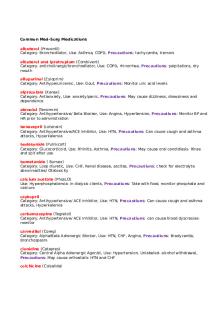
Common Med Surg Meds
- 7 Pages

Med surg dorris bowman
- 4 Pages
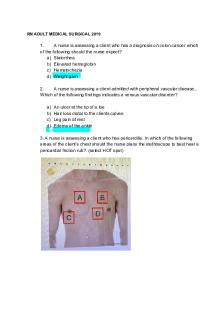
Med surg - notes
- 28 Pages
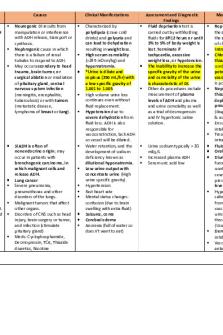
Med-Surg Endocrine
- 11 Pages
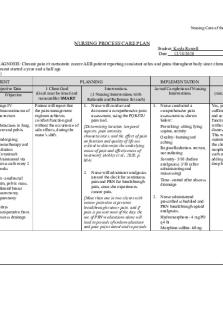
Med Surg- Care Plan
- 6 Pages
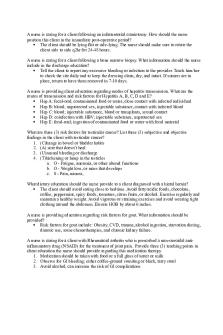
Med-Surg Capstone remediation
- 4 Pages

Med Surg Exam 3
- 19 Pages
Popular Institutions
- Tinajero National High School - Annex
- Politeknik Caltex Riau
- Yokohama City University
- SGT University
- University of Al-Qadisiyah
- Divine Word College of Vigan
- Techniek College Rotterdam
- Universidade de Santiago
- Universiti Teknologi MARA Cawangan Johor Kampus Pasir Gudang
- Poltekkes Kemenkes Yogyakarta
- Baguio City National High School
- Colegio san marcos
- preparatoria uno
- Centro de Bachillerato Tecnológico Industrial y de Servicios No. 107
- Dalian Maritime University
- Quang Trung Secondary School
- Colegio Tecnológico en Informática
- Corporación Regional de Educación Superior
- Grupo CEDVA
- Dar Al Uloom University
- Centro de Estudios Preuniversitarios de la Universidad Nacional de Ingeniería
- 上智大学
- Aakash International School, Nuna Majara
- San Felipe Neri Catholic School
- Kang Chiao International School - New Taipei City
- Misamis Occidental National High School
- Institución Educativa Escuela Normal Juan Ladrilleros
- Kolehiyo ng Pantukan
- Batanes State College
- Instituto Continental
- Sekolah Menengah Kejuruan Kesehatan Kaltara (Tarakan)
- Colegio de La Inmaculada Concepcion - Cebu


